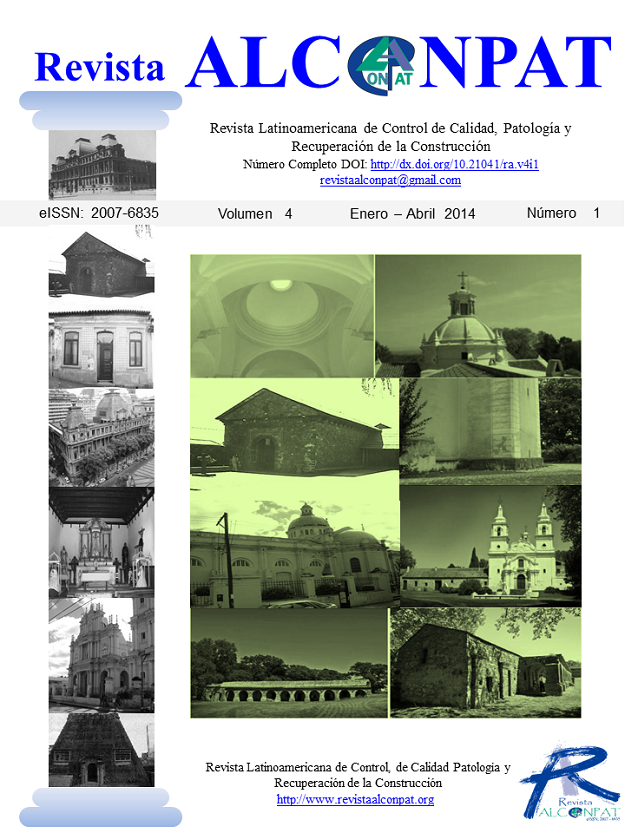Tratamento da humidade ascensional no património histórico
DOI:
https://doi.org/10.21041/ra.v4i1.57Keywords:
rising damp, historical building, hygroregulated systemAbstract
Rising damp linked with the salts is a factor in old buildings walls degradation, which requires
knowledge of its higrothermal behavior, as well as the treatment techniques and its
effectiveness knowledge. The rising damp treatment is very complex and many of the
techniques to solve the problem do not show the desirable effectiveness. The Building Physics
Laboratory of the Faculty of Engineering of the University of Porto has developed numerical
and experimental research that allowed the validation of a technology based on the wall base
hygroregulated ventilation to treat rising damp, patent the system-HUMIVENT.
This paper aims to describe the pathologies associated to rising damp; the advantages and
disadvantages of the most common available technologies for its treatment; characterize the
rising damp treatment system-HUMIVENT, their implementation in Portuguese buildings and
the analysis of the obtained results.
Keywords: rising damp, historical building, hygroregulated system
Downloads
References
Colombert, R. (1975). “L’Humidité des bâtiments anciens; Causes et effets”; Diagnostic et remèdes, Paris, Editions du Moniteur, 182 pgs.
Freitas, V.P.de (1992). “Transferência de humidade em paredes de edifícios”, PhD Thesis. FEUP, Porto, Portugal.
Freitas, V.P.de, Guimarães, A. S. (2008). “Characterization of a hygro-regulated Wall Base Ventilation System for Treatment of Rising Damp in Historical Buildings”. Proceedings of the 2nd Nordic Symposium on Building Physics, pp 911-919 – Copenhagen, Denmark.
Freitas, V.P. de, Torres, M.I.M., Guimarães, A. S. (2008) “Humidade Ascensional”, FEUP edições; ISBN . 978-972-752-101-2; 1.ª edição, Porto.
Guimarães, A. S. (2008). “Caracterização Experimental do Funcionamento de Sistemas de Ventilação da Base das Paredes para Tratamento da Humidade Ascensional”, Master Thesis, FEUP, Porto, Portugal.
Guimarães, A.S. (2011). “Dimensionamento de Sistemas de Ventilação da Base das Paredes para Tratamento da Humidade Ascensional”, Tese de Doutoramento, Faculdade de Engenharia da Universidade do Porto – FEUP, Porto, Portugal.
Guimarães, A. S., Delgado, J. M. P. Q., Freitas, V. P. de, (2010), “Mathematical Analysis of the Evaporative Process of a New Technological Treatment of Rising Damp in Historic Buildings”, Building and Environment, Vol. 45 (11), 2414-2420. DOI: https://doi.org/10.1016/j.buildenv.2010.05.007
Holm, A.; Kunzel, H.M. (2003). “Proceedings of the 2nd international conference on building physics”, pp 363-367 - Leuven, Belgium.
Torres, M.I.M. (2004). “Humidade Ascensional em Paredes de Construções Históricas”, tese de Doutoramento, Coimbra, FCTUC.
Torres, M.I.M., Freitas, V.P. (2003). “Rising damp in historical buildings - Research in Building Physics”, Proceedings of the 2nd international conference on building physics, pp 369-375 - Leuven, Belgium. DOI: https://doi.org/10.1201/9781003078852-53
Torres, M.I.M., Freitas, V.P. (2006). “Avaliação da eficiência da ventilação da base das paredes em função da sua espessura no tratamento das humidades ascensionais”, Patorreb 2006 – Porto, Portugal. WORLD INTELECTUAL PROPERTY ORGANIZATION. http://www.wipo.int/pctdb/en/wo.jsp?WO=2010093272 (12/05/2010).
Downloads
Published
How to Cite
Issue
Section
License
_______________________________
License in effect from September 2020
You are free to:
- Share — copy and redistribute the material in any medium or format for any purpose, even commercially.
- Adapt — remix, transform, and build upon the material for any purpose, even commercially.
- The licensor cannot revoke these freedoms as long as you follow the license terms.
Under the following terms:
- Attribution — You must give appropriate credit , provide a link to the license, and indicate if changes were made . You may do so in any reasonable manner, but not in any way that suggests the licensor endorses you or your use.
- No additional restrictions — You may not apply legal terms or technological measures that legally restrict others from doing anything the license permits.
Notices:
You do not have to comply with the license for elements of the material in the public domain or where your use is permitted by an applicable exception or limitation .
No warranties are given. The license may not give you all of the permissions necessary for your intended use. For example, other rights such as publicity, privacy, or moral rights may limit how you use the material.





















.png)














